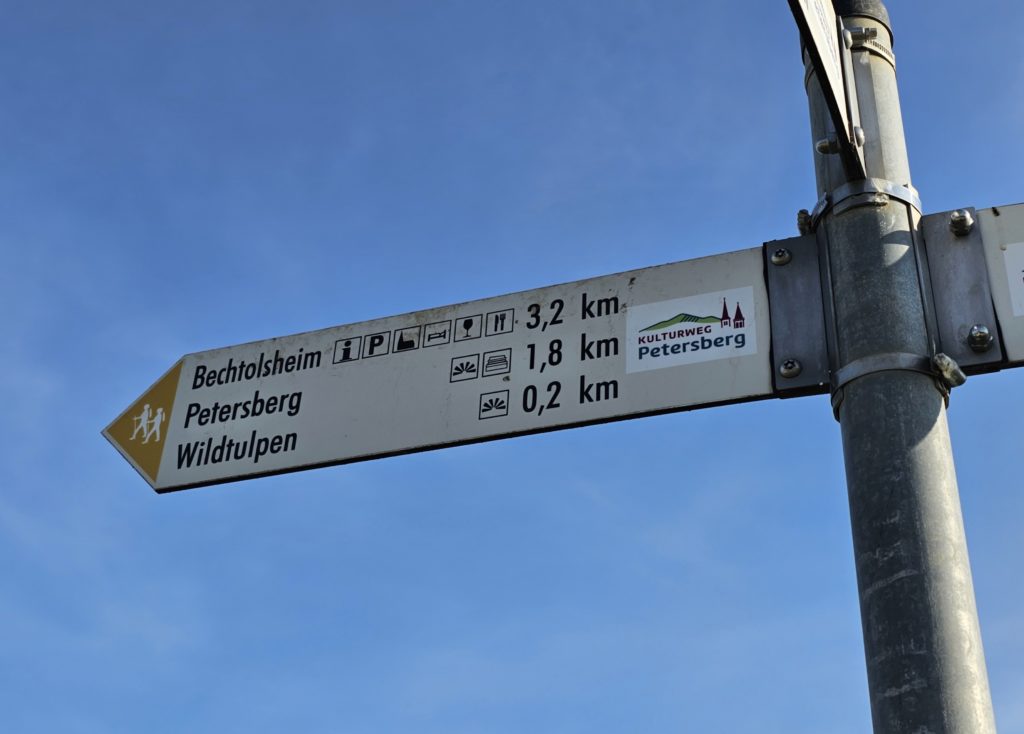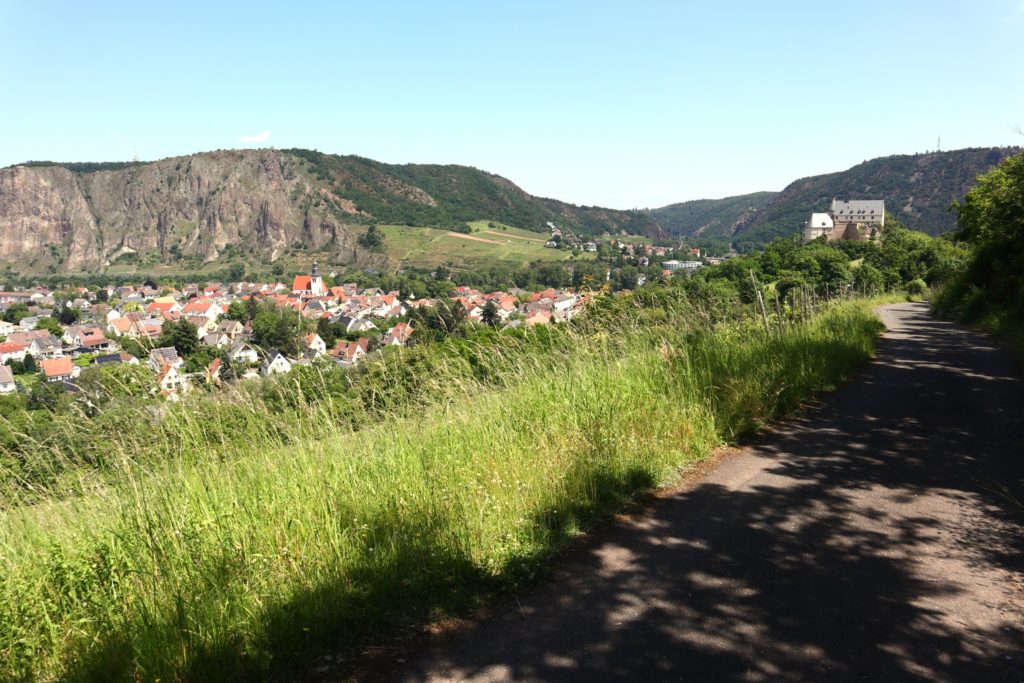This article was published on 03.04.2023 and updated on 29.02.2024.
Yellow for cheerfulness and joie de vivre: the rare wild tulips of Gau-Odernheim

This treasure may adorn itself with a superlative: "largest occurrence of wild tulips north of the Alps".. To admire the Tulipa sylvestris (so the Latin name) is only a few weeks a year usually between mid-April and early May - next week is likely to be. We find: A real excursion tip - yellow stands for cheerfulness and joie de vivre.

Our author Marina Noble has been to the site several times in recent years. She met Manfred Brunn, chairman of the Gau-Odernheim nature conservation group, and learned a lot of interesting facts. The 125 members of the group are committed to protecting the protected plants. They have even accompanied the chairman his whole life: "Even as a boy, the tulips were there, but nobody was interested in them. Nature conservation was still unknown back then." As a result, pesticides and intensive cultivation of the vineyards caused the population to continue to shrink. When the green idea became more and more widespread in the 1980s, Manfred Brunn and some friends became active. They succeeded in having the plants placed under nature protection by the district administration in 1985 - a basis for their preservation.

Already 40 years ago "Flower of the year
Also the "Foundation for the Protection of the the wife of the former German chancellor, the "Foundation for the Protection of endangered plants" recognized the threat early on and named the wild tulip "Flower of the the wild tulip as "Flower of the Year" exactly 40 years ago. The justification can be read on the Foundation website: "The many tulip cultivars that appear in spring in great gardens in spring, but also in flower shops, have caused the decline of the tulip. The decline of the wild tulip has gone almost unnoticed. Yet it is - similar like the yellow narcissus - one of the most remarkable and lovable spring flowers. whose disappearance has made this much-praised season darker in color and more gloomier and poorer in its diversity."

Where do the wild tulips?
Originally the tulip species was at home in the Mediterranean region. There it was considered a particularly noble plant. There are various theories about how it found its way to us, which no one can verify. Manfred Brunn considers this story to be the most Manfred Brunn considers this story to be the most probable. outside the city walls in the Middle Ages were also attended by traders from Italy. Among their goods were wild tulip bulbs, which they wanted to sell as a remedy. However, these did not However, they did not sell very well, probably because the locals were too skeptical. So the merchants simply threw the bulbs away in the nearby vineyards. There they multiplied wildly. Good for us!

Why do the flowers just there?
On the Lieberg, the plants find ideal conditions. They like the nutrient-rich, moist and permeable loess/loam soil. Another positive factor is the climate with plenty of sunshine and little precipitation, for which Rheinhessen is known. for. Another important factor is that the winegrowers take care of the plants when cultivating the vineyards. plants when cultivating the vineyards. In the garden at home, the Flowers do not grow, by the way - so it makes no sense to dig up bulbs. The is forbidden anyway!
How do the tulips look like?
They belong to the family of the lily family - as, by the way, does the yellow daffodil. Outside the flowering season, the bulbous plants are practically unrecognizable. When fully grown they grow to a height of 30 to 60 centimeters. The up to 30 centimeters long, blue-green leaves are narrow and pointed. The likewise pointed calyxes sit on a stem. If you pay close attention to the colors, you will see: they are greenish or reddish on the outside. The bright yellow color is on the inside of the petals. on the inside.

When can they be seen?
The exact flowering time depends on various weather factors and lasts a maximum of three weeks, usually in the period from mid-April to early May. If it is hot, the natural spectacle can be over after just one week. Also, the flowers open only in good weather. They close in bad weather and when it gets dark. Information is available from Manfred Brunn, Tel: 07733-6636, e-mail: m_brunn@t-online.de.
How do I get there?
The most environmentally and therefore tulip-friendly way, of course, is by bicycle. If you're on the Selz Valley Cycle Path, you'll also pass through the hilly countryside of Gau-Odernheim. The scenic route follows the Selz River from its source to its mouth (total length: 68.6 kilometers). Selz Valley Cycle Route - Tours - Rheinhessen. From surrounding cities such as Worms or Wörrstadt there are buses to Gau-Odernheim. For cars, there are nearby parking spaces at the Petersberghalle. From there, a slightly ascending path about one kilometer long leads to the foot of the Lieberg. It is paved and well signposted. Initial information is provided by a signboard before crossing the Selz River.

Are the wild tulips only in Gau-Odernheim?
Nowhere are there said to be as many as there in the "largest occurrence of wild tulips north of the Alps." In Rheinhessen you can find a smaller occurrence at different places in the castle park of the Worms district of Herrnsheim (also at other times of the year the castle and the beautiful the beautiful adjoining 10.5 hectare park, which is considered to be the most important English Rhineland-Palatinate, is a worthwhile destination for an excursion). excursion destination). Also smaller sites are located in the vineyards of the Landau district of Mörzheim and in Franconia.
WILD TULIP BLOSSOM FESTIVAL, SO APRIL 28, 2024
The Gau-Odernheim nature conservation group has dedicated an event of its own to its botanical treasure at its nature experience site. The wild tulip blossom festival puts the rare plants in the spotlight during guided tours. From the festival site, a tractor shuttle takes visitors who don't want to walk to Lieberg - there and back, or just one way. Interesting facts and explanations about nature and bird conservation are also available at the fairground. Objects of demonstration are a bee hotel, the bat hut and a dry stone wall. An idea for your home could be the Benjes hedge. This hedge, made of branches, shrubs and grass, develops over time into a habitat for birds, hedgehogs, insects and other small animals.

ON THE WAY IN THE AREA
Gau-Odernheim: The community on the Selz River with its half-timbered houses in the old town center is worth a tour. A special feature is the Gothic simultaneous church from the 14th/15th century. There, a wall separates the Catholic and Protestant parts.
Information and accommodation directory: Gau-Odernheim - The small center in the heart of Rheinhessen
PetersbergThe highest elevation in Rheinhessen, 246 meters, is directly opposite the Lieberg. The relatively steep climb is rewarded at the top by a wide panoramic view as far as the Taunus and the Frankfurt skyline. Remains of a Romanesque church remind us that the Petersberg was the destination of pilgrims long ago. A beautiful circular route between Gau-Odernheim and Bechtolsheim is the seven-kilometer-long "Petersberg Cultural Trail. Cultural trail Petersberg - Tours - Rheinhessen

Reading tip for a hike to the wild tulips and Petersberg: Hiking to the Petersberg and the wild tulips near Gau-Odernheim, a blog post by Frank Hamm.





2 Responses
Thanks for pointing out my blog article and the link! In two weeks I will try to catch the wild tulips in bloom again.
Thank you for the kind message, dear colleague, and enjoy your wild tulip viewing this year! Best regards, Marina Noble